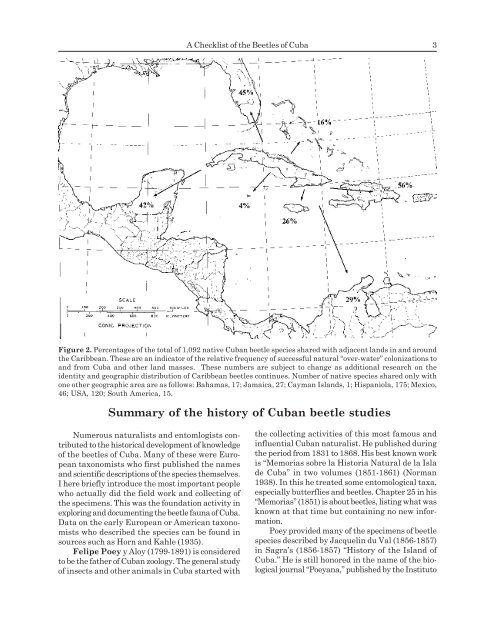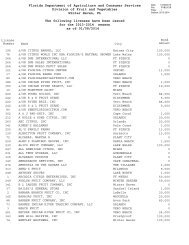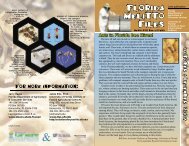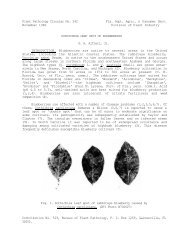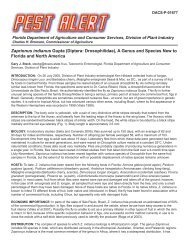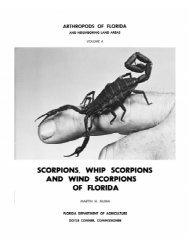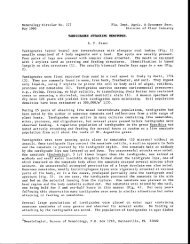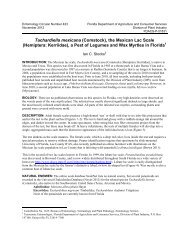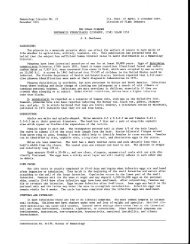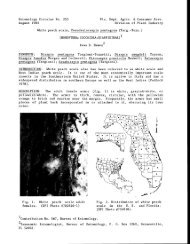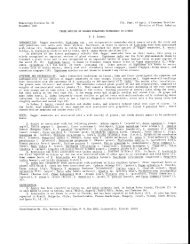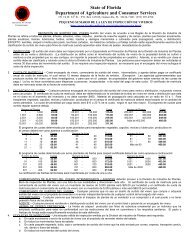A Checklist of the Beetles of Cuba with Data on Distributions and ...
A Checklist of the Beetles of Cuba with Data on Distributions and ...
A Checklist of the Beetles of Cuba with Data on Distributions and ...
You also want an ePaper? Increase the reach of your titles
YUMPU automatically turns print PDFs into web optimized ePapers that Google loves.
A <str<strong>on</strong>g>Checklist</str<strong>on</strong>g> <str<strong>on</strong>g>of</str<strong>on</strong>g> <str<strong>on</strong>g>the</str<strong>on</strong>g> <str<strong>on</strong>g>Beetles</str<strong>on</strong>g> <str<strong>on</strong>g>of</str<strong>on</strong>g> <str<strong>on</strong>g>Cuba</str<strong>on</strong>g> 3<br />
Figure 2. Percentages <str<strong>on</strong>g>of</str<strong>on</strong>g> <str<strong>on</strong>g>the</str<strong>on</strong>g> total <str<strong>on</strong>g>of</str<strong>on</strong>g> 1,092 native <str<strong>on</strong>g>Cuba</str<strong>on</strong>g>n beetle species shared <str<strong>on</strong>g>with</str<strong>on</strong>g> adjacent l<strong>and</strong>s in <strong>and</strong> around<br />
<str<strong>on</strong>g>the</str<strong>on</strong>g> Caribbean. These are an indicator <str<strong>on</strong>g>of</str<strong>on</strong>g> <str<strong>on</strong>g>the</str<strong>on</strong>g> relative frequency <str<strong>on</strong>g>of</str<strong>on</strong>g> successful natural “over-water” col<strong>on</strong>izati<strong>on</strong>s to<br />
<strong>and</strong> from <str<strong>on</strong>g>Cuba</str<strong>on</strong>g> <strong>and</strong> o<str<strong>on</strong>g>the</str<strong>on</strong>g>r l<strong>and</strong> masses. These numbers are subject to change as additi<strong>on</strong>al research <strong>on</strong> <str<strong>on</strong>g>the</str<strong>on</strong>g><br />
identity <strong>and</strong> geographic distributi<strong>on</strong> <str<strong>on</strong>g>of</str<strong>on</strong>g> Caribbean beetles c<strong>on</strong>tinues. Number <str<strong>on</strong>g>of</str<strong>on</strong>g> native species shared <strong>on</strong>ly <str<strong>on</strong>g>with</str<strong>on</strong>g><br />
<strong>on</strong>e o<str<strong>on</strong>g>the</str<strong>on</strong>g>r geographic area are as follows: Bahamas, 17; Jamaica, 27; Cayman Isl<strong>and</strong>s, 1; Hispaniola, 175; Mexico,<br />
46; USA, 120; South America, 15.<br />
Summary <str<strong>on</strong>g>of</str<strong>on</strong>g> <str<strong>on</strong>g>the</str<strong>on</strong>g> history <str<strong>on</strong>g>of</str<strong>on</strong>g> <str<strong>on</strong>g>Cuba</str<strong>on</strong>g>n beetle studies<br />
Numerous naturalists <strong>and</strong> entomlogists c<strong>on</strong>tributed<br />
to <str<strong>on</strong>g>the</str<strong>on</strong>g> historical development <str<strong>on</strong>g>of</str<strong>on</strong>g> knowledge<br />
<str<strong>on</strong>g>of</str<strong>on</strong>g> <str<strong>on</strong>g>the</str<strong>on</strong>g> beetles <str<strong>on</strong>g>of</str<strong>on</strong>g> <str<strong>on</strong>g>Cuba</str<strong>on</strong>g>. Many <str<strong>on</strong>g>of</str<strong>on</strong>g> <str<strong>on</strong>g>the</str<strong>on</strong>g>se were European<br />
tax<strong>on</strong>omists who first published <str<strong>on</strong>g>the</str<strong>on</strong>g> names<br />
<strong>and</strong> scientific descripti<strong>on</strong>s <str<strong>on</strong>g>of</str<strong>on</strong>g> <str<strong>on</strong>g>the</str<strong>on</strong>g> species <str<strong>on</strong>g>the</str<strong>on</strong>g>mselves.<br />
I here briefly introduce <str<strong>on</strong>g>the</str<strong>on</strong>g> most important people<br />
who actually did <str<strong>on</strong>g>the</str<strong>on</strong>g> field work <strong>and</strong> collecting <str<strong>on</strong>g>of</str<strong>on</strong>g><br />
<str<strong>on</strong>g>the</str<strong>on</strong>g> specimens. This was <str<strong>on</strong>g>the</str<strong>on</strong>g> foundati<strong>on</strong> activity in<br />
exploring <strong>and</strong> documenting <str<strong>on</strong>g>the</str<strong>on</strong>g> beetle fauna <str<strong>on</strong>g>of</str<strong>on</strong>g> <str<strong>on</strong>g>Cuba</str<strong>on</strong>g>.<br />
<str<strong>on</strong>g>Data</str<strong>on</strong>g> <strong>on</strong> <str<strong>on</strong>g>the</str<strong>on</strong>g> early European or American tax<strong>on</strong>omists<br />
who described <str<strong>on</strong>g>the</str<strong>on</strong>g> species can be found in<br />
sources such as Horn <strong>and</strong> Kahle (1935).<br />
Felipe Poey y Aloy (1799-1891) is c<strong>on</strong>sidered<br />
to be <str<strong>on</strong>g>the</str<strong>on</strong>g> fa<str<strong>on</strong>g>the</str<strong>on</strong>g>r <str<strong>on</strong>g>of</str<strong>on</strong>g> <str<strong>on</strong>g>Cuba</str<strong>on</strong>g>n zoology. The general study<br />
<str<strong>on</strong>g>of</str<strong>on</strong>g> insects <strong>and</strong> o<str<strong>on</strong>g>the</str<strong>on</strong>g>r animals in <str<strong>on</strong>g>Cuba</str<strong>on</strong>g> started <str<strong>on</strong>g>with</str<strong>on</strong>g><br />
<str<strong>on</strong>g>the</str<strong>on</strong>g> collecting activities <str<strong>on</strong>g>of</str<strong>on</strong>g> this most famous <strong>and</strong><br />
influential <str<strong>on</strong>g>Cuba</str<strong>on</strong>g>n naturalist. He published during<br />
<str<strong>on</strong>g>the</str<strong>on</strong>g> period from 1831 to 1868. His best known work<br />
is “Memorias sobre la Historia Natural de la Isla<br />
de <str<strong>on</strong>g>Cuba</str<strong>on</strong>g>” in two volumes (1851-1861) (Norman<br />
1938). In this he treated some entomological taxa,<br />
especially butterflies <strong>and</strong> beetles. Chapter 25 in his<br />
“Memorias” (1851) is about beetles, listing what was<br />
known at that time but c<strong>on</strong>taining no new informati<strong>on</strong>.<br />
Poey provided many <str<strong>on</strong>g>of</str<strong>on</strong>g> <str<strong>on</strong>g>the</str<strong>on</strong>g> specimens <str<strong>on</strong>g>of</str<strong>on</strong>g> beetle<br />
species described by Jacquelin du Val (1856-1857)<br />
in Sagra’s (1856-1857) “History <str<strong>on</strong>g>of</str<strong>on</strong>g> <str<strong>on</strong>g>the</str<strong>on</strong>g> Isl<strong>and</strong> <str<strong>on</strong>g>of</str<strong>on</strong>g><br />
<str<strong>on</strong>g>Cuba</str<strong>on</strong>g>.” He is still h<strong>on</strong>ored in <str<strong>on</strong>g>the</str<strong>on</strong>g> name <str<strong>on</strong>g>of</str<strong>on</strong>g> <str<strong>on</strong>g>the</str<strong>on</strong>g> biological<br />
journal “Poeyana,” published by <str<strong>on</strong>g>the</str<strong>on</strong>g> Instituto


